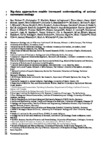Big-data approaches lead to an increased understanding of the ecology of animal movement
| dc.contributor.author | Whiteside, Mark | |
| dc.date.accessioned | 2022-05-03T10:23:42Z | |
| dc.date.issued | 2022-02-18 | |
| dc.identifier.issn | 0036-8075 | |
| dc.identifier.issn | 1095-9203 | |
| dc.identifier.other | ARTN eabg1780 | |
| dc.identifier.uri | http://hdl.handle.net/10026.1/19137 | |
| dc.description.abstract |
<jats:p>Understanding animal movement is essential to elucidate how animals interact, survive, and thrive in a changing world. Recent technological advances in data collection and management have transformed our understanding of animal “movement ecology” (the integrated study of organismal movement), creating a big-data discipline that benefits from rapid, cost-effective generation of large amounts of data on movements of animals in the wild. These high-throughput wildlife tracking systems now allow more thorough investigation of variation among individuals and species across space and time, the nature of biological interactions, and behavioral responses to the environment. Movement ecology is rapidly expanding scientific frontiers through large interdisciplinary and collaborative frameworks, providing improved opportunities for conservation and insights into the movements of wild animals, and their causes and consequences.</jats:p> | |
| dc.format.extent | 734-+ | |
| dc.format.medium | Print-Electronic | |
| dc.language | en | |
| dc.language.iso | en | |
| dc.publisher | American Association for the Advancement of Science (AAAS) | |
| dc.rights | Attribution-NonCommercial-NoDerivatives 4.0 International | |
| dc.rights.uri | http://creativecommons.org/licenses/by-nc-nd/4.0/ | |
| dc.subject | Animal Migration | |
| dc.subject | Animals | |
| dc.subject | Animals, Wild | |
| dc.subject | Behavior, Animal | |
| dc.subject | Big Data | |
| dc.subject | Data Collection | |
| dc.subject | Ecology | |
| dc.subject | Ecosystem | |
| dc.subject | Environment | |
| dc.subject | Movement | |
| dc.subject | Spatio-Temporal Analysis | |
| dc.title | Big-data approaches lead to an increased understanding of the ecology of animal movement | |
| dc.type | journal-article | |
| dc.type | Journal Article | |
| dc.type | Research Support, Non-U.S. Gov't | |
| dc.type | Review | |
| plymouth.author-url | https://www.webofscience.com/api/gateway?GWVersion=2&SrcApp=PARTNER_APP&SrcAuth=LinksAMR&KeyUT=WOS:000758142600036&DestLinkType=FullRecord&DestApp=ALL_WOS&UsrCustomerID=11bb513d99f797142bcfeffcc58ea008 | |
| plymouth.issue | 6582 | |
| plymouth.volume | 375 | |
| plymouth.publication-status | Published | |
| plymouth.journal | Science | |
| dc.identifier.doi | 10.1126/science.abg1780 | |
| plymouth.organisational-group | /Plymouth | |
| plymouth.organisational-group | /Plymouth/Faculty of Science and Engineering | |
| plymouth.organisational-group | /Plymouth/Faculty of Science and Engineering/School of Biological and Marine Sciences | |
| plymouth.organisational-group | /Plymouth/Users by role | |
| plymouth.organisational-group | /Plymouth/Users by role/Academics | |
| dc.publisher.place | United States | |
| dcterms.dateAccepted | 2022-01-18 | |
| dc.rights.embargodate | 2022-5-4 | |
| dc.identifier.eissn | 1095-9203 | |
| rioxxterms.versionofrecord | 10.1126/science.abg1780 | |
| rioxxterms.licenseref.uri | http://creativecommons.org/licenses/by-nc-nd/4.0/ | |
| rioxxterms.type | Journal Article/Review |



